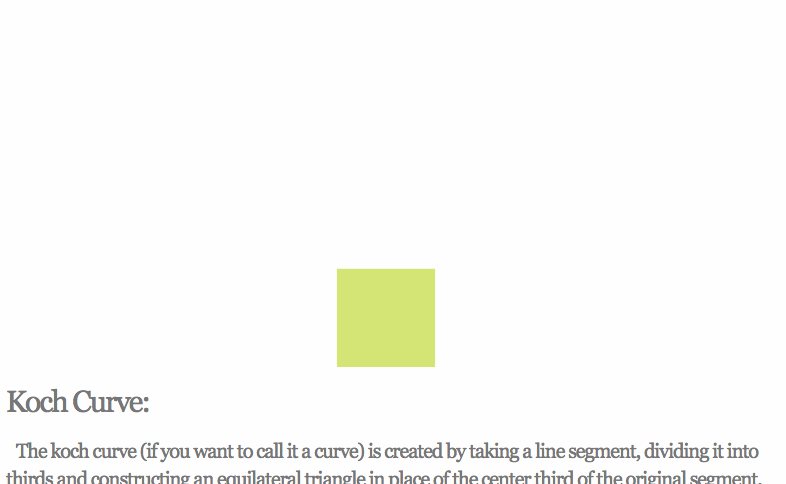So… this started as an article about why recursion doesn't work in React. It looks like it works, then you npm run build, and it stops working.
Curious, right? Worth looking into, eh?
That's not the article you're getting. It started as that article, then I spent 3 hours building a Pythagoras tree fractal. It's 2:30am, and is my life even real?
Who the hell accidentally spends all night building fractals? Me… I guess.

Pretty, innit? Built with React, and it's going to stop working when I npm run build. Still don't know why. I'll figure that out next week.
Here's how the Pythagoras tree works:
The construction of the Pythagoras tree begins with a square. Upon this square are constructed two squares, each scaled down by a linear factor of ½√2, such that the corners of the squares coincide pairwise. The same procedure is then applied recursively to the two smaller squares, ad infinitum.
?
That becomes four bullet points:
- 1 component called
<Pythagoras > - draws rectangle
- calculates props for next 2 rectangles
<Pythagoras><Pythagoras>
Which turns into some 30 lines of code:
import React from 'react';
import { interpolateViridis } from 'd3-scale';
const Factor = .5*Math.sqrt(2);
const Pythagoras = ({ maxlvl, w, x, y, lvl, left, right }) => {
if (lvl > maxlvl || w < 1) {
return null;
}
const nextLeft = Factor*w,
nextRight = Factor*w,
d = nextLeft + nextRight + w,
A = 45,
B = 45;
let rotate = '';
if (left) {
rotate = `rotate(${-A} 0 ${w})`;
}else if (right) {
rotate = `rotate(${B} ${w} ${w})`;
}
return (
<g transform={`translate(${x} ${y})="" ${rotate}`}="">
<rect width={w} height={w} x={0} y={0} style="{{fill:" interpolateviridis(lvl="" maxlvl)}}="">
<pythagoras w={nextLeft} x={w-nextLeft} y={-nextLeft} lvl={lvl+1} maxlvl={maxlvl} right="">
<pythagoras w={nextRight} x={0} y={-nextRight} lvl={lvl+1} maxlvl={maxlvl} left="">
</pythagoras></pythagoras></rect></g>
);
};
export default Pythagoras;
Beautiful. Let me explain.
interpolateViridis is a d3-scale that gives beautiful colors. Call it with an argument in [0, 1] and it returns a color.
Factor is the constant linear factor. We use it to calculate the sides of future rectangles.
d is the diameter of the triangle formed by the current square and two future squares. More on that later.
A and B are angles for each future rectangle. Set to 45 degrees statically.
Then we start drawing.
If we're in a left rectangle, we set up a left rotation; if right then a right rotation. rotate() is an SVG transformation that rotates the current coordinate system.
To draw the rectangle, we:
translateto(x, y), that means "move there"- add the rotation
- now our coordinate system is moved and rotate
- draw a rectangle at
(0, 0) - add two
<Pythagoras>with new parameters
And that's how you build a fractal in React. It won't work in production, but it sure looks pretty on your localhost.

The animation is done in App.js with a timer that updates the maxlvl prop every 500ms. Calling the root node of Pythagoras looks like this:
<pythagoras
w={100}
x={320 - 50}
y={480 - 100}
lvl={0}
maxlvl="{this.state.currentMax}/"
></pythagoras>
Start lvl at 0 and set the maxlvl. Those are important. At maxlvl past 12 or 13, it stops working. It takes too much CPU power to ever render.
Yes, I tried. The naive algorithm isn't good enough. You could optimize by taking calculations out of recursion and preparing them in advance.
The part I can't figure out
Look at Andrew Hoyer's Pythagoras tree. That thing is beautiful and flexible and dances like tree-shaped worm.

?
I can't figure out how to calculate those angles and rectangle sizes. I know that using .5 in the Factor is for 45 degree angles.
You can change the ratio by using a .3 and .7 factor for each side. Then it stops working with 45 degree angles yeah.

Ok, that was expected. Since you know all the sides, you should be able to apply the Law of Sines to calculate the angle.
const nextLeft = 0.3 * Factor * w,
nextRight = 0.7 * Factor * w,
d = nextLeft + nextRight + w,
A = Math.degrees(Math.asin(nextRight / d)),
B = Math.degrees(Math.asin(nextLeft / d));

I can't figure it out. I'm pretty sure I'm applying the Law of Sines correctly, but the numbers it throws out are wrong.
Halp ?
PS: Here's a paper that describes using Pythagoras trees as data structures. Sort of.
Continue reading about Fractals in React
Semantically similar articles hand-picked by GPT-4
- Dancing tree fractal with React
- Screw web performance, just wait a little 😈
- A Dancing Rainbow Snake – An Example of Minimal React and D3v4 transitions
- Animating 2048 SVG nodes in React, Preact, Inferno, Vue, Angular 2, and CycleJS – a side-by-side comparison
- Anything's a sorting problem if you squint hard enough
Learned something new?
Read more Software Engineering Lessons from Production
I write articles with real insight into the career and skills of a modern software engineer. "Raw and honest from the heart!" as one reader described them. Fueled by lessons learned over 20 years of building production code for side-projects, small businesses, and hyper growth startups. Both successful and not.
Subscribe below 👇
Software Engineering Lessons from Production
Join Swizec's Newsletter and get insightful emails 💌 on mindsets, tactics, and technical skills for your career. Real lessons from building production software. No bullshit.
"Man, love your simple writing! Yours is the only newsletter I open and only blog that I give a fuck to read & scroll till the end. And wow always take away lessons with me. Inspiring! And very relatable. 👌"
Have a burning question that you think I can answer? Hit me up on twitter and I'll do my best.
Who am I and who do I help? I'm Swizec Teller and I turn coders into engineers with "Raw and honest from the heart!" writing. No bullshit. Real insights into the career and skills of a modern software engineer.
Want to become a true senior engineer? Take ownership, have autonomy, and be a force multiplier on your team. The Senior Engineer Mindset ebook can help 👉 swizec.com/senior-mindset. These are the shifts in mindset that unlocked my career.
Curious about Serverless and the modern backend? Check out Serverless Handbook, for frontend engineers 👉 ServerlessHandbook.dev
Want to Stop copy pasting D3 examples and create data visualizations of your own? Learn how to build scalable dataviz React components your whole team can understand with React for Data Visualization
Want to get my best emails on JavaScript, React, Serverless, Fullstack Web, or Indie Hacking? Check out swizec.com/collections
Did someone amazing share this letter with you? Wonderful! You can sign up for my weekly letters for software engineers on their path to greatness, here: swizec.com/blog
Want to brush up on your modern JavaScript syntax? Check out my interactive cheatsheet: es6cheatsheet.com
By the way, just in case no one has told you it yet today: I love and appreciate you for who you are ❤️
